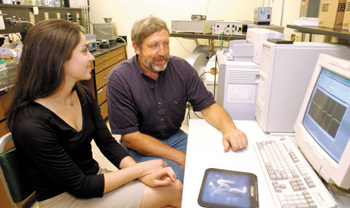
Al Beth, Ph.D., talks to Susan Desensi, the first graduate student of the new program. (photo by Dana Johnson)
Research program shatters boundaries — Students train to span chemical, physical, biological disciplines
Susan Desensi is in a class by herself. Literally. She is the first and only student in a new graduate program at Vanderbilt—the Chemical and Physical Biology program. Not having a peer group can be tough, but Desensi is taking it in stride. “I’m at the top of my class,” she laughed.
The Chemical and Physical Biology (CPB) program targets students who have earned undergraduate degrees in the quantitative sciences—chemistry, computer science, engineering, mathematics, or physics—for doctoral work in research areas that span the boundaries of the chemical, physical, and biological sciences.
The time is ripe for programs that encourage students with quantitative skills to enter the biological research arena, said Albert H. Beth, Ph.D., professor of Molecular Physiology and Biophysics and director of the new graduate program. Taking advantage of the reams of data now being generated by genome sequencing and other advances in technology requires quantitative skills not traditionally found among undergraduates trained in biological sciences.
“A lot of the pushes in biomedical sciences these days—maximum throughput protein structure determination, for example—have told us that to really advance these areas, we need to bring a new group of people into the pool,” Beth said. Students trained in the quantitative sciences can “approach problems at a more fundamental level,” he said. “Rather than relying on existing methodologies, they can actually redesign the methodologies, the applications, and even the theories themselves.”
The CPB program is modeled after the Interdisciplinary Graduate Program (IGP), now in its 10th year of recruiting and training graduate students in the biological and biomedical sciences. “The IGP has been extraordinarily successful,” Beth said, “and we obviously hope the CPB program will be as well.”
This fall marks the first full-fledged recruiting effort for the program, which aims to recruit 10 students per year. As in the IGP, students who enter the CPB program will spend the first year in coursework—a core course and electives tailored to the individual student—and research rotations designed to allow students to sample several research areas or laboratories. Students may choose mentors from any of the participating departments in the College of Arts and Science-Biological Sciences, Chemistry, Mathematics, and Physics, or in the School of Medicine.
The coursework will be more flexible than that offered to IGP students, Beth said. “It’s a real challenge to design a program that will get such a diverse group of students up to speed and going in research in these interdisciplinary areas. Our goal is for these students to be able to recognize important biological problems and to have the quantitative tools to approach those problems differently than IGP students would be prepared to do.”
Vanderbilt provides an ideal environment for the student interested in spanning the borders between the quantitative and biological sciences, Beth said. “First and foremost, we have a number of very good scientists who work in these areas.” And there is continuing investment in the general area of quantitative biology on campus, with additional faculty being recruited in the College of Arts and Science and in the Medical Center including in the new Center for Structural Biology.
“We also have the pure luxury of proximity between departments,” Beth added. “It is extremely unusual to have a world-class medical center sitting right next door to the university’s College of Arts and Science.”
Dennis G. Hall, Ph.D., associate provost for Research, and Lee E. Limbird, Ph.D., associate vice chancellor for Research have fully supported the new program on behalf of the College of Arts and Science and the School of Medicine, respectively. Their support, and that of Roger Chalkley, D.Phil., senior associate dean for Biomedical Research Education and Training, has put Vanderbilt at the front of a national trend, Beth said. “There are programs just now starting to spring up around the country that are addressing the needs of training students at the interface of the quantitative and biological sciences.”
Desensi, the sole member of the first CPB class, concurred that Vanderbilt’s program is currently one of only a handful. The opportunities it offered appealed to her. “I wasn’t ready to be restricted to graduate studies and research in one discipline,” she said, “and the CPB program didn’t force me to make that choice prematurely.”
Next year, she expects to lose her special status as the only student in the CPB program. “I know plenty of people majoring in chemistry or physics or math who have an interest in biology and will be attracted to programs that allow them to combine those interests,” she said.
For more information about the CPB program, visit the Web site: http://medschool.mc.vanderbilt.edu/bret_cpb/.













